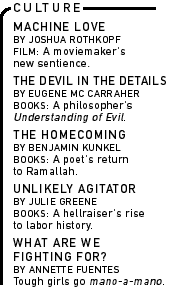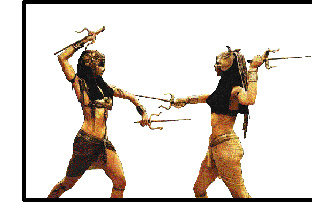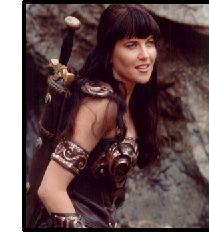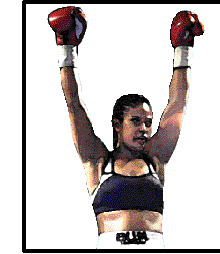

|

|

|

|
|
|
| |
|
||
|
Inching along the West Side highway of Manhattan recently, my gaze strayed to one of the giant billboards looming above, advertising to a car-bound captive audience. It promoted The Mummy Returns, a film sequel to 1999's box office hit. Faces of several of the male characters peered out menacingly, but what really caught my eye was the action at the foreground of the billboard: two women done up in skimpy faux ancient Egyptian-style outfits going at each other with these nasty trident weapons. Forget those moldy old mummies. This movie is selling hot mamas going mano-a-mano. If you can actually sit through the movie, you will learn that the rivalry between archaeologist Evelyn O'Connell and her nemesis Meela spans a couple of thousand years. Their fight scene, a sort of exhibition match before a pharaoh and his high priest, is an eclectic mix of cartwheels and kick-boxing, spears and broad axes, with some gravity-defying wall climbing thrown in for good measure. All this is performed, need I say, in the most minimal of clothing designed for maximum exposure as the girls throw down. Now, women in sexy garb is as clichéd as this movie. Actress Angelina Jolie's latest
Inness points to Sarah Connor, the muscular mom-turned-guerrilla fighter of the Terminator films, and Xena: Warrior Princess as just two examples of the culture's acceptance of--even affinity for--women who'd rather crack skulls than crack eggs for a soufflé. There's something else going on here, though, with the tough-babe trend, which Inness notes has its origins in the early '60s, with the jumpsuit-clad Emma Peel in The Avengers. What stopped me cold in the Mummy billboard was the spectacle of the girl fight and the sense of déjà vu it triggered. Hadn't there been another recent film in which two women really go at it with a vengeance? Of course, it was Crouching Tiger, Hidden Dragon, the first Chinese-language film to achieve mainstream, popular success among U.S. moviegoers. While actor Chow Yun Fat is the ostensible star, his role is all but overshadowed by the action of his female co-stars, martial artists Michelle Yeoh and Zhang Ziyi. Their fight scenes are the heart of this lushly filmed fable of good and evil, with fantastic choreography that sends the combatants scooting up and down buildings and tripping across trees. Yeoh and Ziyi look good while they're trading kicks and wielding a variety of sharp weapons, proving that girls who fight can still be ladies. But I'm not ready to ascribe liberating potential to these portrayals of women who beat
Girl fights superficially seem to offer women a more nuanced, multidimensional persona, an acknowledgement that, yes, women can be angry and violent just like men. And sometimes they want to kill each other, not just their husbands or boyfriends, a thought that must be reassuring to men in a post-feminist world. But how different are these cinematic girl fights from "cat fights," the stereotypical female clashes that have formed the basis of countless male fantasies, sexual and otherwise, such as mud wrestling and its jiggly variants? As Inness argues, the tough woman in popular culture expands the boundaries of traditional female stereotypes while simultaneously ensuring that gender roles are never really turned topsy-turvy. Kick-box yourself into a frenzy, but when you're done, make sure your mascara isn't smudged. Just that kind of mixed message about babes who fight was the subtext of the June 8 match between Laila Ali and Jacqui Frazier-Lyde in their first bout at the Turning Stone Casino in upstate New York. As the daughters of boxers Muhammad Ali and "Smokin' " Joe Frazier, Laila, 23, and Jacqui, 39, have spent the past year trying to invent boxing careers and a rivalry built on their fathers' legends. Ali, whose ring name is "She Bee Stinging," is a model and looks it; Frazier-Lyde, known as "Sister Smoke," is an attorney and smart enough to know she can earn more leveraging her father's legacy than trudging to court--a couple of million for stepping into the ring with Ali, who won the 8-round decision. While women's boxing is soaring in popularity--both as a fitness craze and as a competitive sport--few observers consider the Ali-Frazier match-up as anything other than show biz. Wrote sports columnist Vic Ziegel in the New York Daily News: "Ali and Frazier, important names in heavyweight boxing history, are ready to punch at each other again. The difference this time is that it's a hustle. Only the names are the same." Ziegel is an old timer and perhaps a bit cranky when it comes to women busting onto a
Boxing as an avenue to liberation or at least self-realization is the theme of Karyn Kusama's film Girlfight, an indie production that KO'd the competition at last year's Sundance Film Festival. It's a fine film, not least because of its star Michelle Rodriguez as Diana, a Latina Rocky who defies her father and channels her rage at the local gym. "In this world of gendered expectations, it's very scary to see violent women," Kusama told Cynthia Fuchs in an interview for Reelimages.com. "Somehow we assume it's the province of men, and in many ways it is. But there's another kind of underlying violence in that assumption, which is that women don't have that rage and capability for violence in themselves." But as much as I'd like to cheer Diana, watching her punch out other black and brown women--and men--is less inspiring than depressing; boxing as a route out of urban despair and poverty is well-worn and often a dead end. And Kusama's story seems hardly radical today, probably because women boxing nowadays is more yuppie-chic than taboo. More radical is the plot of the film Billy Elliot, in which a working-class English boy forsakes boxing lessons for ballet, sending his coal-mining father and brother into paroxysms of rage. Billy's world is steeped in violence (even more so than Diana's), both at home and outside, where striking miners wage battle against scabs and the police. When Billy sheds his boxing gloves and laces up ballet slippers, it is an act of defiance and courage that feels monumental. His choice is out of oppression and toward self-fulfillment. Girl fights and the fascination with aggressive, violent women
might reflect one part of our reality. But in a culture primed by
violence, buying into the male domain of aggression as a way to
smash gender stereotypes is really all about getting sucker punched.
Annette Fuentes is an In These Times contributing editor.
|




